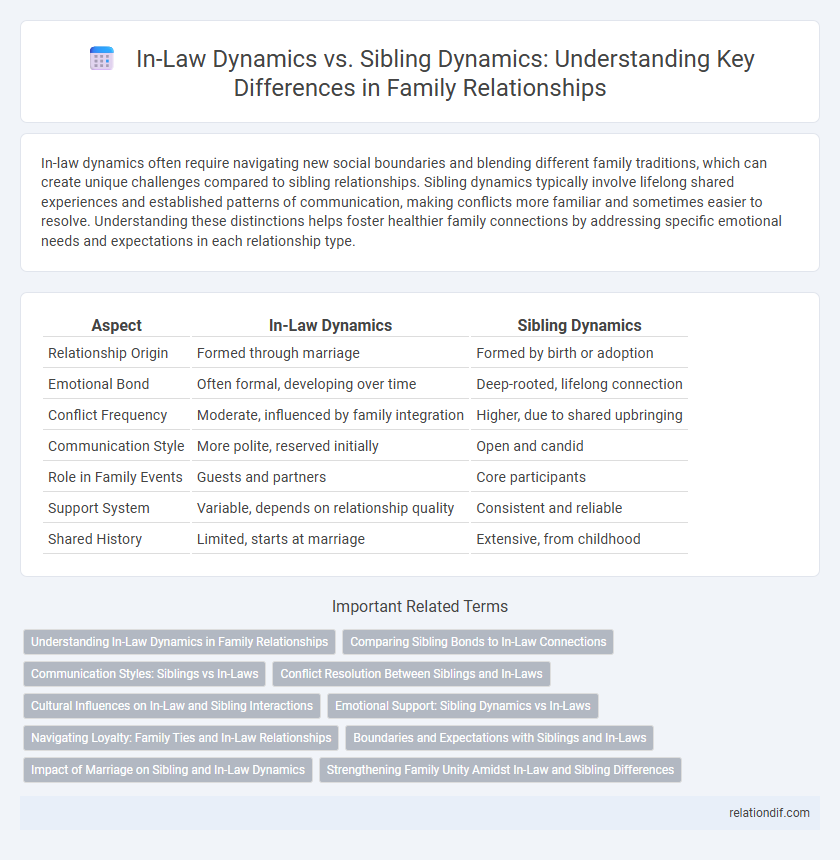In-law dynamics often require navigating new social boundaries and blending different family traditions, which can create unique challenges compared to sibling relationships. Sibling dynamics typically involve lifelong shared experiences and established patterns of communication, making conflicts more familiar and sometimes easier to resolve. Understanding these distinctions helps foster healthier family connections by addressing specific emotional needs and expectations in each relationship type.
Table of Comparison
| Aspect | In-Law Dynamics | Sibling Dynamics |
|---|---|---|
| Relationship Origin | Formed through marriage | Formed by birth or adoption |
| Emotional Bond | Often formal, developing over time | Deep-rooted, lifelong connection |
| Conflict Frequency | Moderate, influenced by family integration | Higher, due to shared upbringing |
| Communication Style | More polite, reserved initially | Open and candid |
| Role in Family Events | Guests and partners | Core participants |
| Support System | Variable, depends on relationship quality | Consistent and reliable |
| Shared History | Limited, starts at marriage | Extensive, from childhood |
Understanding In-Law Dynamics in Family Relationships
In-law dynamics often involve navigating boundaries and blending traditions, which can differ significantly from sibling relationships that are usually rooted in lifelong shared experiences and established roles. Understanding in-law dynamics requires recognizing the importance of mutual respect, communication, and cultural sensitivity to foster harmony within the extended family structure. Effective management of these relationships can enhance family cohesion and prevent conflicts that commonly arise from differing expectations and perspectives.
Comparing Sibling Bonds to In-Law Connections
Sibling bonds often involve lifelong shared experiences, deep emotional understanding, and a foundation built during childhood, creating a unique sense of loyalty and familiarity. In-law connections develop through marriage, requiring intentional effort to build trust and navigate differing family traditions, which can lead to more complex relational dynamics. While siblings typically share a collective history, in-laws frequently balance integration with maintaining individual family boundaries, influencing the nature of their interactions.
Communication Styles: Siblings vs In-Laws
Sibling dynamics often feature direct, familiar communication shaped by shared childhood experiences, fostering a casual and sometimes confrontational exchange. In-law communication usually requires more formality and sensitivity, as relationships are newer and involve different family cultures and expectations. Effective navigation of these styles necessitates recognizing boundaries and adapting tone to maintain harmony across both family groups.
Conflict Resolution Between Siblings and In-Laws
Conflict resolution between siblings often centers on shared history, emotional bonds, and parental influence, whereas in-law disputes typically arise from differing family traditions, boundaries, and expectations. Effective strategies include open communication, empathy, and setting clear boundaries to navigate loyalty conflicts and reduce tension. Understanding the unique dynamics of each relationship fosters mutual respect and long-term harmony within the extended family.
Cultural Influences on In-Law and Sibling Interactions
Cultural norms significantly shape in-law dynamics and sibling relationships by defining roles, expectations, and boundaries within the family structure. In collectivist cultures, in-law interactions often emphasize respect, obligation, and harmony, while sibling relationships may center on lifelong support and shared responsibilities. Contrastingly, individualistic societies promote autonomy and egalitarianism, influencing more flexible and negotiable interactions among both in-laws and siblings.
Emotional Support: Sibling Dynamics vs In-Laws
Sibling dynamics often provide a foundation for consistent emotional support shaped by shared history and deep-rooted trust. In-law relationships, while potentially supportive, tend to be more variable in emotional closeness due to differing family cultures and boundaries. Understanding these distinctions helps navigate the unique emotional needs within family systems.
Navigating Loyalty: Family Ties and In-Law Relationships
Navigating loyalty in family ties requires understanding the distinct dynamics between in-law and sibling relationships, where siblings often share a lifelong bond rooted in shared experiences, while in-laws bring external perspectives and new relational challenges. Balancing allegiance involves recognizing the differing expectations and boundary negotiations inherent in each relationship, promoting open communication and mutual respect to maintain harmony. Prioritizing empathy and adaptability helps reconcile potential conflicts, fostering cohesion in blended family systems.
Boundaries and Expectations with Siblings and In-Laws
Establishing clear boundaries and managing expectations are crucial in both sibling and in-law dynamics to maintain healthy family relationships. Siblings often share a lifelong history and emotional connection, which can lead to implicit expectations, whereas in-law relationships require intentional communication to define roles and limits. Respecting personal space and acknowledging differing family cultures help prevent conflicts and foster mutual understanding in both types of relationships.
Impact of Marriage on Sibling and In-Law Dynamics
Marriage significantly reshapes sibling and in-law dynamics by introducing new relational boundaries and roles, often requiring negotiation between loyalty to birth family and commitment to a spouse. In-law relationships can create both opportunities for expanded family connections and sources of conflict due to differing expectations and cultural norms. Siblings may experience shifts in closeness and communication patterns as priorities adjust around marital commitments.
Strengthening Family Unity Amidst In-Law and Sibling Differences
Navigating in-law dynamics alongside sibling relationships requires open communication and mutual respect to foster family unity. Understanding distinct family roles and setting clear boundaries helps alleviate conflicts and promotes cooperation. Prioritizing shared values and empathy strengthens bonds despite differences, creating a supportive family environment.
in-law dynamics vs sibling dynamics Infographic

 relationdif.com
relationdif.com